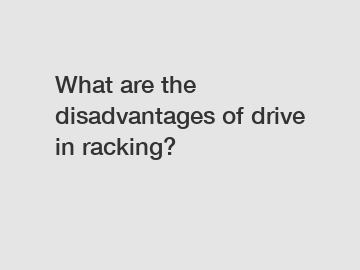What are the disadvantages of drive in racking?
What are the Disadvantages of Drive-in Racking?
Drive-in racking is a popular storage solution that maximizes warehouse space utilization by allowing forklifts to drive directly into the racking system to deposit or retrieve pallets. While drive-in racking offers several advantages, such as increased storage capacity and easy accessibility, it also has its fair share of disadvantages. This article will explore some of the drawbacks associated with drive-in racking.
Limited Selectivity: .

One major disadvantage of drive-in racking is its limited selectivity. Since pallets are stored one behind the other, it becomes challenging to access specific pallets within the system. Unlike other racking systems like selective racking, where each pallet has its own dedicated location, drive-in racking only allows access to the first pallet in the row. This lack of selectivity can be a significant drawback in warehouses where frequent stock rotation or quick access to individual pallets is necessary.
Potential Damage to Racking and Pallets:
Another disadvantage of drive-in racking is the potential for damage to both the racking system and the pallets themselves. Since forklifts drive directly into the racking, there is an increased risk of accidental collisions that can damage the racking uprights and beams. Moreover, the repetitive nature of inserting and extracting pallets in the confined spaces of the drive-in racking increases the likelihood of pallet damage, such as cracked boards or broken support blocks. These damages can compromise the structural integrity of the racking system and reduce its overall lifespan.
Limited Storage Flexibility:
Drive-in racking is best suited for storing large quantities of the same product, making it less flexible compared to other storage solutions. Due to its configuration, only one SKU can be stored in each lane at a time, limiting the storage options for warehouses that deal with multiple SKUs or have varying sizes of pallets. This lack of flexibility can make drive-in racking less suitable for businesses that require frequent changes in their inventory or have a diverse range of products.
Reduced Throughput:
Due to its limited selectivity and restrictive storage configuration, drive-in racking often results in reduced throughput. Retrieving pallets from the middle or back rows can be time-consuming as each pallet in the front row must be removed first. This can lead to longer retrieval times, slower picking rates, and potential delays in fulfilling orders. Businesses that require high throughput and quick order fulfillment may find drive-in racking less efficient compared to other racking systems.
Occupancy of Valuable Floor Space:
Drive-in racking requires ample aisle space to accommodate forklift movement within the system. This means that a significant portion of the warehouse floor space becomes occupied by aisles, reducing the overall storage capacity of the facility. For warehouses with limited space, drive-in racking may not be the most optimal choice as it sacrifices storage density in favor of accessibility.
In conclusion, while drive-in racking offers advantages in terms of increased storage capacity and accessibility, it is important to consider its disadvantages as well. The limited selectivity, potential damage to racking and pallets, limited storage flexibility, reduced throughput, and the occupation of valuable floor space are all factors that businesses must carefully evaluate before opting for drive-in racking. If you have further questions or require assistance in determining the most suitable racking solution for your warehouse, please don't hesitate to contact us.
Want more information on light duty pallet racking, Automated Multidimensional Warehouse, medium duty rack? Feel free to contact us.
119
0
0


Comments
All Comments (0)